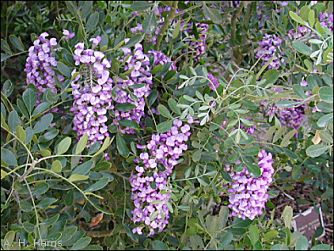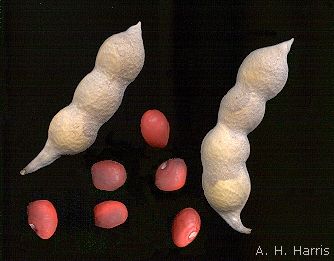
Many of the plants of the desert tend to be shy and retiring—but not the Mescal Bean! Large clusters of purple flowers among rich green leaves proclaim to the high heavens that spring is here. Not content with merely visual beauty, a most pleasant scent fills the air. Widely prized for its flowers, its evergreen foliage, and its water-stingy ways, it graces many a native plant garden. And, more and more, even the traditional plantings.
A member of the bean family, it bears its seeds in pods, with
constrictions between the contained beans. The ripe beans are a bright red, so
attractive that they are made into jewelry. Various authorities warn that the beans are
poisonous to humans, but you'd sure have to work hard to get yourself poisoned—the
bean is so hard that even a steel file hardly fazes it. Some earlier Native Americans,
however, were willing to work hard to live dangerously, grinding the seeds to a powder
and mixing it with mescal beverages to produce a powerful intoxicating—and potentially
deadly—drink.
![]()
Contributor: Arthur H. Harris, Laboratory for Environmental Biology, Centennial Museum, University of Texas at El Paso.
Desert Diary is a joint production of the Centennial Museum and KTEP National Public Radio at the University of Texas at El Paso.


Flowers and foliage; pods and seeds of the Mescal Bean plant, also known as Mountain Laurel. Images by A. H. Harris.
Vines, Robert A. 1960. Trees, shrubs, and woody vines of the
Southwest. University of Texas Press, Austin. 1104 p. ![]()